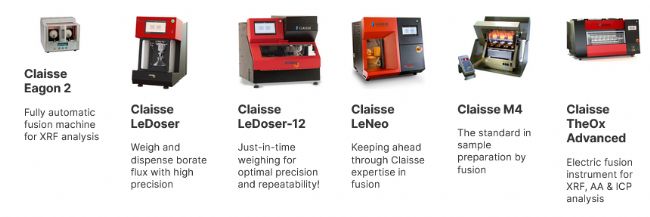Sample preparation for XRF and ICP
Easy sample preparation for accurate XRF analysis
Good sample preparation is essential for performing high-quality chemical analysis using X-ray fluorescence (XRF). Whichever samples are being assessed – loose or pressed powders, fused beads, solid samples or liquids – finding the right approach to sample preparation for XRF is the first, and one of the most important, steps in achieving accurate and reproducible results.
Sample preparation greatly increases the accuracy of the analytical results and unlike other analytical techniques, XRF analysis does not require extensive sample preparation work. Sample preparation methods are inexpensive, straightforward, fast, easy to learn and automated. Allowing the operator to perform other valuable tasks in the laboratory.
Malvern Panalytical – your partner in sample preparation
As pioneers and world leaders in XRF analysis, Malvern Panalytical is the ideal partner for sample preparation – every step of the way. Thanks to decades of application experience, we are at the forefront of all XRF sample preparation methods and developments, and have the knowledge necessary to help with all XRF sample preparation requirements.

Claisse - the world leader in sample prep by fusion
Claisse joined the team of Malvern Panalytical in 2014. Since then, both companies are working in synergy to offer a complete range of products and a larger body of knowledge in the field of XRF analysis.
What is fusion?
Fusion is a sample preparation method developed in the mid 50s. It consists in dissolving at high temperatures a fully oxidized sample in a suitable solvent (a flux) in a platinum, zirconium or graphite crucible. The melted mixture is agitated and poured into a mold to create a glass disk for XRF analysis. It can be poured into a beaker to create a solution for AA or ICP analysis.
Why should I use fusion in my laboratory?
This universal technique has numerous benefits when you compare it with other sample preparation methods such as pressed pellet.
Benefits of fusion
- Leads to highly accurate and repeatable results
- Processes a wide variety of samples from polymer to ferroalloys
- Simple, fast and efficient
- Very cost-effective
- Clean and safe
- The analytical results are not affected by mineralogy and particle size effects
- Easy calibration and application of matrix correction

bio-equip.cn
We draw on the power of our analytical instruments and services to make the invisible visible and the impossible possible. Through the chemical, physical and structural analysis of materials, our high-precision analytical systems and top-notch services support our customers in creating a better world, helping them to improve everything from the energies that power us and the materials we build with, to the medicines that cure us and the foods we enjoy. We partner with many of the world’s biggest companies, universities and research organizations. They value us not only for the power of our solutions, but also for the depth of our expertise, collaboration and integrity. With over 2200 employees, we serve the world, and we are part of Spectris plc, the world-leading precision measurement group.
Malvern Panalytical. We’re BIG on small?.